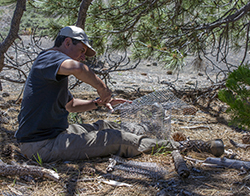
Lassics lupine grows under protective cages.

Richard Macedo, Habitat Conservation Planning Branch Chief constructs a cage to protect rare, endangered Lassics lupine.

Lassics lupine grows under protective cages.
Biologists from three government natural resource agencies banded together this summer in an unusual effort to help preserve a species under threat of extinction. They lugged materials to build wire cages into the rough terrain of the remote Lassics mountains near the border of Humboldt and Trinity counties in an effort to protect their target. However, these cages were not built to trap animals; they were constructed to keep animals out.
The barren, green serpentine slopes of Mount Lassic, located in a seldom-visited part of Six Rivers National Forest, are home to one of California’s rarest plants: the Lassics lupine (Lupinus constancei). Lassics lupine is a short plant in the pea family that has bright rose-pink flowers. Only approximately 450 adult Lassics lupine plants were observed during 2017 monitoring of the species conducted by the U.S. Forest Service and the U.S. Fish and Wildlife Service, with assistance from CDFW.
Rodents such as deer mice, squirrels and chipmunks have been eating so many Lassics lupine seeds from the plants that, absent intervention, the species appears to be on the path to extinction within the next 50 years (Kurkjian et al. 2016).
Biologists believe that historical suppression of fires in Six Rivers National Forest beginning in the early 1900s may be indirectly responsible for the encroachment of forest and chaparral into Lassics lupine habitat. Fires that were put out quickly did not grow large enough to reduce encroaching forest, and therefore the forest expanded. With the encroaching vegetation came more seed-eating rodents that depend on vegetation cover for protection from predators.
In 2003, the U.S. Forest Service, U.S. Fish and Wildlife Service and other researchers began an emergency attempt to halt Lassics lupine’s trend towards extinction. Each summer, biologists set off on the laborious hike up Mount Lassic to place cylindrical wire cages over as many flowering Lassics lupine plants as possible. Each cage is anchored to the ground to prevent rodents from squeezing underneath.
The cages are remarkably effective at stopping rodents when properly installed, and they remain on the plants for the duration of the growing season. After Lassics lupine fruits have matured, they often split open suddenly and send seeds flying through the air up to 13 feet away. The cages are then removed each year before the onset of winter snow.
“Protecting endangered species is California’s policy and plants like the Lassics lupine could disappear within our lifetimes,” explained Jeb Bjerke, a biologist with CDFW’s Native Plant Program. “We should do what we can to save these unique plants for the future.”
In 2015, in the midst of an historic drought, an 18,200-acre fire spread through the Lassics, killing many Lassics lupine plants and charring the chaparral vegetation nearby. The fire had little effect on the forest that encroaches into Lassics lupine habitat, but preliminary studies suggest that the fire may have reduced rodent density in the burned chaparral. Despite the apparent reduction in rodent density following the fire, the impact from rodents eating Lassics lupine seeds remains high. Continued caging of Lassics lupine plants therefore remains critical for preventing extinction of the species until a more permanent solution can be implemented, such as significant reduction of encroaching forest. However, such efforts are expensive to plan and implement. As the primary land manager, the U.S. Forest Service would likely be the lead agency in future protective actions.
In 2016, the California Fish and Game Commission received a petition to list Lassics lupine as an endangered species under the California Endangered Species Act and the species was designated a candidate species earlier this year. CDFW is in the process of producing a status review for Lassics lupine that will include a recommendation to the California Fish and Game Commission on whether listing the species is warranted. The legislature directs all state agencies, including CDFW, to seek the conservation of endangered and threatened species.
“I hope that CDFW can continue to partner with the U.S. Forest Service and U.S. Fish and Wildlife Service to protect the Lassics lupine from extinction,” Bjerke said.
For additional information on this subject, please see:
California Department of Fish and Wildlife photos by Jeb Bjerke